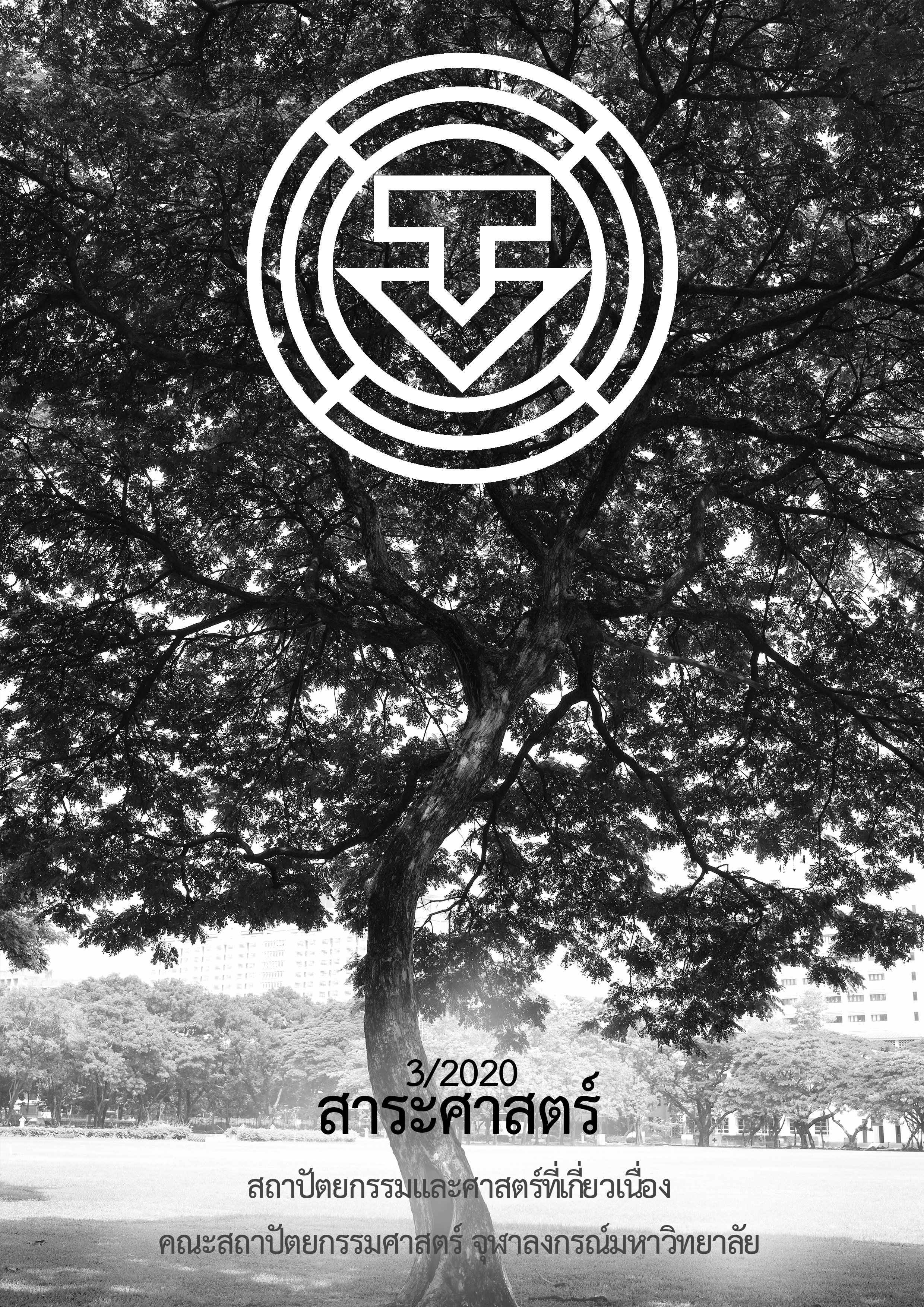Classification and Analysis of Upper Yom Riverscape : Case Study of Ban Donchaisakthong, Amphoe Song, Changwat Phrae : CASESTUDY OF BAN DONCHAISAKTHONG, AMPHOE SONG, CHANGWAT PHRAE.
Main Article Content
Abstract
Riverscapes are distinctive parts of landscapes which flow through a river that performs the geologic process. Dynamic hydrologic conditions of both discharge and sediment supply impact rivers and their ecosystems that provide a diverse range of services upon which humans rely. Consequently, there is a relationship between humans and the ecosystem. This research focuses on Ban-donchaisakthong, located in the upper part of the Yom river watershed, Thailand. This village has a traditional lifestyle that related to the riverscape.
The purpose of this study is to classify and analyze elements of upper Yom riverscape which are consist of seasonal dynamic and ecosystem services. These ecosystem services support livelihood and culture which results in humans receiving information directly from the environment and viewing its holistically. Therefore, It showed that the interptation of visual form in the environment can be directly perceived as the scenery. It become the upper Yom river ecological knowledge which creates understanding and awareness of the conservation of riverscape.
The method consists of Image classification from the satellite data and interviewing villager for ecosystem services that connect to the relationship between human and cultural service. The result is the landscape character of the upper Yom riverscape which can be defined as 2 outstanding types; aquatic ecosystem: rapid and bars and terrestrial Ecosystem: poeng and phae forests. Extracting elements of the scenery have outstanding characteristics of landform that stones are various sizes, grouping, and distribution. Riverscape is different in which characteristics of vegetation are dominant from trees and bamboos that shapes are long and straight trunk.
Article Details
References
กรมทรัพยากรธรณี. “ธรณีวิทยา จังหวัดแพร่และแหล่งเรียนรู้ทางธรณีวิทยา.” สืบค้น 4 กุมภาพันธ์ 2563. http://www.dmr.go.th/download/teacher/Phrae/doc_phra.pdf.
TCIJ. “‘เครือข่ายลุ่มน้ำยม’ แฉปริมาณน้ำ ง้อข้อ ‘กบอ.- รมต.’ ดันเขื่อน.” สืบค้น 12 มกราคม 2563. https://www.tcijthai.com/news/2012/15/archived/1119.
ปวร มณีสถิตย์. “ความเปลี่ยนแปลงของโครงข่ายลำเหมืองพญาคำ อำเภอเมือง จังหวัดเชียงใหม่.” วิทยานิพนธ์ปริญญามหาบัณฑิต คณะสถาปัตยกรรมศาสตร์ จุฬาลงกรณ์มหาวิทยาลัย, 2559.
มนตรี ชูวงศ์. ธรณีสัณฐานวิทยาพื้นฐาน. พระนครศรีอยุธยา: เทียนวัฒนาพริ้นท์ติ้ง, 2554.
แม่น้ำยม ป่าสักทอง: วิถีชีวิตของคนสะเอียบ. กรุงเทพมหานคร: southeast asia rivers network, 2549.
วลัยลักษณ์ ทรงศิริ. “ชาวสะเอียบและโครงการแก่งเสือเต้น.” สืบค้น 12 มกราคม 2563. http://lek-prapai.org/home/view.php?id=826.
สุธาวัลย์ เสถียรไทย. การประเมินค่าทางเศรษฐศาสตร์ของป่าไม้: กรณีศึกษามูลค่าที่ไม่มีการใช้ประโยชน์ของป่าไม้สักในอุทยานแห่งชาติแม่ยมจากการสร้างเขื่อนแก่งเสือเต้น. กรุงเทพฯ: สถาบันธรรมรัฐเพื่อการพัฒนาสังคมและสิ่งแวดล้อม, (ม.ป.ป.).
เหมือนพิมพ์ สุวรรณกาศ. “หุบเขาแพร่และน่าน.”สืบค้นเมื่อ 14 มกราคม 2563. http://lek-prapai.org/home/view.php?id=106.
อรกมล นิละนนท์. “การบ่งชี้การบริการระบบนิเวศทางวัฒนธรรมในพื้นที่ลุ่มแม่น้ำห้วยปูด อำเภอท่าวังผา จังหวัดน่าน.” วิทยานิพนธ์ปริญญามหาบัณฑิต คณะสถาปัตยกรรมศาสตร์ จุฬาลงกรณ์มหาวิทยาลัย, 2560.
Andreatta, S. and G. Ferraro. Elements of Culture: An Applied Perspective. Independence, KY.: Cengage, 2013.
Bayley, P. B., and R. E. Sparks. “The Flood Pulse Concept in River-Floodplain Systems.” The Canadian Journal of Fisheries and Aquatic Sciences (1989): 110-127.
Eller, J. D. Cultural Anthropology: Global Forces, Local Lives. 2nd ed. New York: Routledge, 2013.
The Federal Interagency Stream Restoration Working Group. Stream Corridor Restoration: Principles, Processes, and Practices. New York: National Service Center for Environmental Publications (NSCEP), 1998.
Haslam, S. M., M. A. and S. D. The River and Riverscape. New York: Cambridge University Press, 2008.
Junk, W. J. The Central Amazon Floodplain. New York: Springer-Verlag, 1997.
Leopold, A. A Sand County Almanac and Sketch Here and There. New York: Oxford University Press, 1949.
Marsh, W. M. Landscape: An Introduction to Physical Geography. Ann Arbor, MI.: The University of Michigan, 1981.
Millenium Ecosystem Assessment. Ecosystems and Human Well-Being: Synthesis. Washington, D.C.: Island Press, 2005.
Nassauer, J.I. Placing Nature Culture and Landscape Ecology. Washington, D.C.: Island Press, 1997.
Norton, W. Cultural Geography. Oxford: Oxford University Press, 2006.
Pretty, J. N., B. Adam, F. Berkes, S. F. de Athayde, N. Dudley, E. Hunn . . . S. Pilgrim."The International of Biological Diversity and Cultural Diversity: Toward Integration.” Conversation and Society 7(2009): 100 – 112.
Steward, J. H. Theory of Cultural Change: The Methodology of Multilinear Evolution. Champaign, IL.: University of Illinois Press, 1979.
Terkenli, T. S. “Towards a Theory of the Landscape: The Aegean Landscape as a Cultural Image.” Landscape and Urban Planning 57(2001): 197-208.
Thorp, J. H., C. M. Thoms and M.D. Delong. The Riverine Ecosystem Synthesis. Amsterdam: Elsevier’s Science & Technology Rights, 2008.
Thorp, J. H., J. E. Flotemersch, M. Delong and A. F. Casper. “Linking Ecosystem Services, Rehabilitation, and River Hydrogeomorphology.” Bioscience 60(2010): 67-74.
Vannote, R., G. Minshall, K. Cummins, J. Sedell and C. Cushing. “The River Continuum Concept.” Canadian Journal of Fisheries and Aquatic Sciences 37(1980): 130-137.


